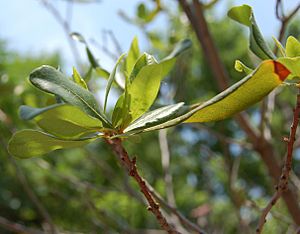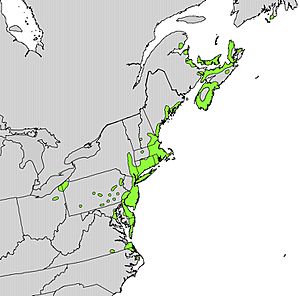Northern bayberry facts for kids
Quick facts for kids Northern bayberry |
|
|---|---|
 |
|
| Scientific classification | |
| Genus: |
Myrica
|
| Species: |
pensylvanica
|
 |
|
| Natural range | |
| Synonyms | |
|
Morella pensylvanica |
|
The northern bayberry (scientific name: Myrica pensylvanica) is a special type of shrub that grows in eastern North America. You can find it from Newfoundland in Canada, west to Ontario and Ohio, and south all the way to North Carolina. It's also sometimes called Morella pensylvanica.
This plant is a deciduous shrub, which means it loses its leaves in the fall. It can grow quite tall, up to 4.5 meters (about 15 feet). Its leaves are usually 2.5 to 7 centimeters long. If you crush them, they feel a bit sticky and have a spicy smell. The plant has small flowers that grow in clusters called catkins. These can be green or red. The fruit is a small, wrinkled berry, about 3 to 5.5 millimeters wide. It has a light blue-purple waxy coating. These berries are a very important food source for birds like the yellow-rumped warbler.
Northern bayberry plants have a cool trick: their roots have tiny helpers! These are special microorganisms that can take nitrogen from the air and turn it into food for the plant. This means the northern bayberry can grow well even in poor soils where other plants might struggle.
Amazing Uses of Northern Bayberry
The berries of the northern bayberry have been used for a long time to make special candles. Early American colonists discovered that if they boiled the berries, they could get a sweet-smelling wax. They used this wax to make candles that burned very cleanly and smelled nice. This was a big deal because most candles back then were made from animal fat and often smelled bad or smoked a lot.


